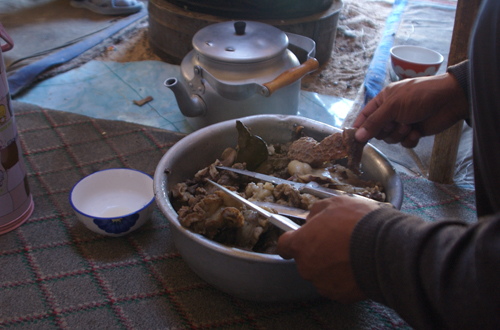
One of the interesting and, to a lot of Westerners, amazing things about traveling in Mongolia is that the thousand-plus year old traditions of hospitality out in the countryside are still practiced. It feels very odd to walk up to someone’s ger (assuming there are no dogs in sight), open the door and walk right in without knocking. After four trips, I still get a twinge doing it.
I found myself very intimidated the first time. There are no windows in a ger and the door is solid wood so, even with a guide, you are walking into someone’s home without any idea of what to expect. Fortunately, the Mongols are patient and understanding, like my first time, when I turned to the right instead of the left and circumnavigated the ger to get to the stool that I was to sit on.
At least I remembered not to step on the threshold or walk between the upright supports.
The older gentleman approved of the fact that I was wearing Mongol boots. He said to me, through my guide “I see Mongol boots and I look up and see… a western face”. It was spring, which means really cold and windy, and they were the warmest footwear I had with me, having purchased them at the State Department Store in UB. They worked, of course. I asked if he would be willing to have his picture taken with a westerner wearing Mongol boots and he immediately sat up, buttoned his del and made room for me to sit beside him on the bed.

Those thermoses keep water hot, hot, hot for over 24 hours. I want one. I just have to figure out how to carry it home.

Now ger visits are one of the things I MOST look forward to when I go to Mongolia. A ger, maybe because of the quality of space that the round shape creates, is one of the most pleasant and peaceful places that I’ve ever been in. I just happily sit sipping milk tea or airag and nibbling aruul as conversations that I don’t understand a word of go back and forth between my guide and our hosts.




Gilmour seems to have relished ger visits also and provided a good description of the customs:
“As for entering tents on the plain, there need be no bashfullness. Any traveler is at perfect liberty to alight at any village he may wish and demand admittance; and any Mongol who refuses admittance, or gives a cold welcome even, is at once stigmatised not a man but a dog. Any host who did not offer tea, without money and without price, would soon earn the same reputation, the reason being, I suppose, that Mongolia has no inn, and all travelers are dependent on private houses for shelter and refreshment. At first sight it seems rather exacting to leap off your horse at the door of a perfect stranger, and expect to find tea prepared and offered to you free; but probably the master of the tent where you refresh yourself is at the same time sitting likewise refreshing himself in some other man’s tent some hundred miles away; and thus the thing balances itself. The hospitality received by Mongols in travelling compensates for the hospitality shown to travelers.”

